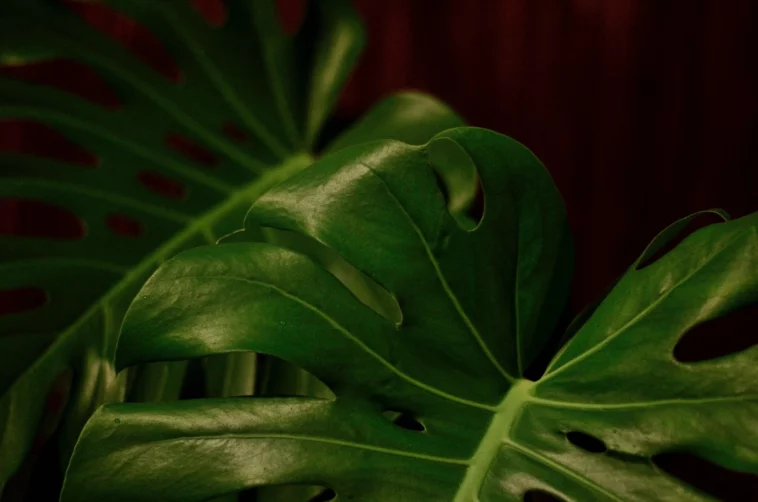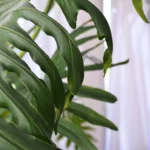Yes, they do. New monstera leaves curl. At first, new leaves are tightly coiled before progressively unfurling as they grow in size. A healthy plant’s new leaf development is a wonderful sign.
When monstera leaves curl, it is typically because the plant has been underwatered or has been exposed to low humidity. Overwatering, pest attacks, excessive heat, or a Monstera that is rootbound are all possible reasons. It is common for new leaves to curl tightly before they begin to unfurl.
Read More: Monstera Leaves Care – A Complete Guide
Table of Contents
6 Ways to Prevent Curling in Monstera Leaves
In this post ,we’ll look at what’s causing your Monstera leaves to curl and how to cure it.
Continue reading, and I’ll go through each problem in turn to assist you figure out how to cure your Monstera plant.
If there is an excessive amount of water loss from the leaves,Monstera plants respond by curling their leaves to minimize their surface area and therefore reduce transpiration.
Monsteras do this as a natural adaptation mechanism, but it may also be an indication that your plant is under stress.
Monstera leaves curling may be caused by any condition that causes water loss or lowers the quantity of water reaching the leaves. Let’s take a look at each reason one at a time.
I’ll go through the signs to watch for, and also the actions you can take to rectify the issue and bring your plant back to full health.
Read More: Why is my monstera drooping and curling
Underwatering
If your Monstera isn’t getting enough water, its leaves will begin to curl. It is among the most widespread reasons of Monstera leaves curling and must be investigated first.
Look for drooping, brownish, crispy leaves tips and edges, and extremely dry soil. Lack of water will cause the plant container to seem considerably lighter than usual.
The easiest answer here is to thoroughly water your Monstera. Water thoroughly till water is drained freely from the bottom of the pot’s drainage holes.
Try to establish a habit of inspecting your Monstera to determine whether it needs watering on a regular basis. Observe the leaves and soil moisture levels on a daily basis, and provide water when the top 1-2 inches of soil feel fully dry.
When it comes to watering your Monstera plant, it’s best not to stick to a scheduled time, since the needs of your plant might change based on a variety of variables, including its growth rate, the season, the container it’s in and the temperature and humidity in the room.
If you are prone to forgetting to water your houseplants, consider putting an alert on your phone every several days to remind you to check on your plant often.
Read More: How do you get monstera leaves to uncurl
Overwatering
This seems to be an uncommon cause of Monstera leaf curling, yet it is perhaps the most dangerous. It’s possible that you’ll be caught off guard and end up with a sickly plant as a result.
Overwatering may cause symptoms similar to those of an underwatered Monstera plant, such as curled leaves. This occurs as a consequence of continually moist soil, which causes the roots to die and prevents water from being taken by the plant, resulting in wilting.
You can identify the difference between underwatering and overwatering by the feel of the soil, as well as other indicators. The leaves of an overwatered Monstera are likely to turn yellow and wilt.
The foliage might curl, but there will be no brown tips or leaf edges, nor will they be dry or crispy.
When a plant shows serious symptoms, root rot is almost always present; thus, inspecting the roots will typically assist you in making the diagnosis.
To examine the roots, you may have to remove the plant from the container. Root rot is characterized by brown or black, mushy roots that are typically accompanied by a decaying stench.
To give your Monstera plant the best chance of recovery, you must act quickly to remove the damaged roots and repot the plant.
Read More: Why are my monstera leaves curling
Low Humidity
Most of those popular houseplants we cultivate come from the understory of rain forests, where temperatures are stable and humidity levels are high.
Our houses are often significantly drier, and so many houseplants fail to adapt with the decreased humidity levels. Low humidity often causes monstera leaves to curl.
While Monsteras can tolerate lower humidity levels than some other famous houseplants, they will usually develop leaf curling if humidity is kept below 40%. Some Monstera species, particularly those that are less common, need exceptionally high humidity levels in order to maintain their appearance.
Low humidity curled Monstera leaves may be distinguished from an underwatering issue by the following characteristics:
- Take a look at the soil. Underwatering is quite uncommon if the soil is kept damp.
- If your Monstera is suffering from low humidity, it is unlikely to wilt.
- Monitor your home’s humidity levels using a digital hygrometer/thermometer. It’s unlikely that low humidity is to blame if the humidity level is usually over 40 percent.
To help your Monstera and other houseplants thrive, there are a variety of methods you may raise the humidity in your home.
- Utilize the transpiration of your plants to generate a humid microclimate in your home or office.
- Place a humidity tray underneath your Monstera. A water-filled drip tray with a broad base is an effective solution. Make sure the pot’s base is slightly above the water level by placing stones around it.
- In order to boost the humidity in your home quickly, you may use a humidifier. Many types let you to choose the humidity level that you want.
Pests
Monsteras aren’t often attacked by houseplant pests, but when they are, they may be severely damaged.
Various sap-sucking insects feed on the plant’s leaves and stems to extract the plant’s liquids, including spider mites, mealybugs, and thrips.
Pests deplete the leaves of water, resulting in the curling of Monstera leaves.
Despite the fact that the plant is taking enough water and nutrients from the soil, the pests that eat the plant exhaust them before they reach the perimeter of the leaves. A consequence of this is that the Monstera leaves curl, as if they are being underwatered.
Be sure to examine the top and bottom of the leaves and stems thoroughly for any signs of pests. Most pests can be found if you search hard enough, but spider mites are so little that they may be overlooked at times.
Use a magnifying lens to examine the leaves up close or check for wispy webs between the leaves.
If you look closely, you may be able to see where pests have eaten leaves. It’s a good indicator if you see yellow dots or rings on the foliage in an uneven pattern.
How To Get Rid Of Pests That Cause Monstera Leaves To Curl
When an infestation is small, it is much simpler to get rid of the pests. Your Monstera plant should be checked for pests on a regular basis as part of your normal maintenance.
Isolate your Monstera plant from the remaining of your houseplants if you find or suspect a pest issue. It’s bad enough if one of your plants is harmed, but if all of your plants are affected, you’ve got a big issue.
When you purchase a new Monstera plant, keep it apart from your older plants for a minimum of seven to ten days to ensure that no bugs are on the leaves.
The kind of pest you have, as well as your personal preferences, influence the treatment choices available for pests on Monsteras.
Heat Stress
Leaf curling in Monsteras may be caused by hot weather or drafts. This may happen fast and is more likely to take place as an intense reaction to a sudden shift in settings.
If your plant is in the way of a heating vent, or if the weather is very hot, this issue may arise. The quick loss of water from the leaves as a consequence of the heat and wind leads the leaves to curl in a hopeless effort to retain some water.
Keep in mind that this issue may arise when the seasons change. During a heatwave in the midst of summer, a Monstera that is normally content in an east-facing window may have a considerably more difficult time.
Taking adequate care of houseplants necessitates being aware of the constantly shifting circumstances and reacting appropriately in order to maintain the health of your Monstera plant.
Being Rootbound or Using an Inappropriate Pot
Identifying the cause of curling Monstera leaves might be a challenge at times, however in this instance, look at the container the plant is in. Your Monstera may take up all of the water it receives in a short period of time if it is still growing in a tiny container.
It’s possible that your plant has gotten rootbound, making it considerably more difficult to satisfy its watering requirements.
Your Monstera’s container and soil may not be holding enough water, and you should consider repotting if the soil seems dry within a few days after watering.
Additionally, you may see several roots emerging out of the drainage openings, and when you pull the plant from its container, the roots will be firmly packed and wrapped around the interior of the container.
Repot into a pot that is 1-2 inches bigger to allow the roots more room to develop and more soil to absorb water and nutrients between waterings.
New Leaves
It is worth noting that there is one reason of curling that is completely natural and should not be a cause for worry.
Even though it’s visible, fresh leaves are tightly curled when they initially emerge and then gradually unfold as they mature. Healthy plant’s new leaves growth is a fantastic indicator.
Conclusion
Do New Monstera Leaves Curl?
Based on my observations, the answer is yes. New leaves initially curl before gradually unfurling as they develop in size and become more visible. It’s a phenomenon which doesn’t seem to hurt the plant nor reduce its growth rate.
The emergence of new leaves on a healthy Monstera plant is an encouraging indication.
Photo by Snow white form PxHere


